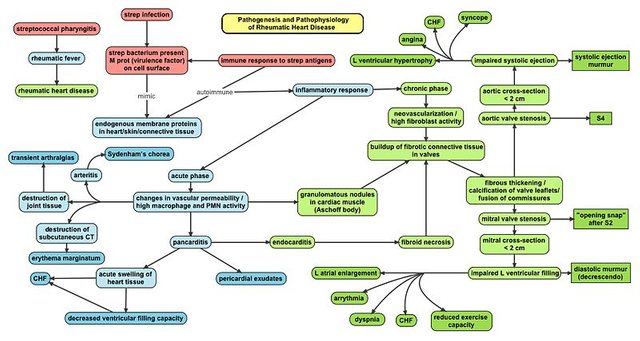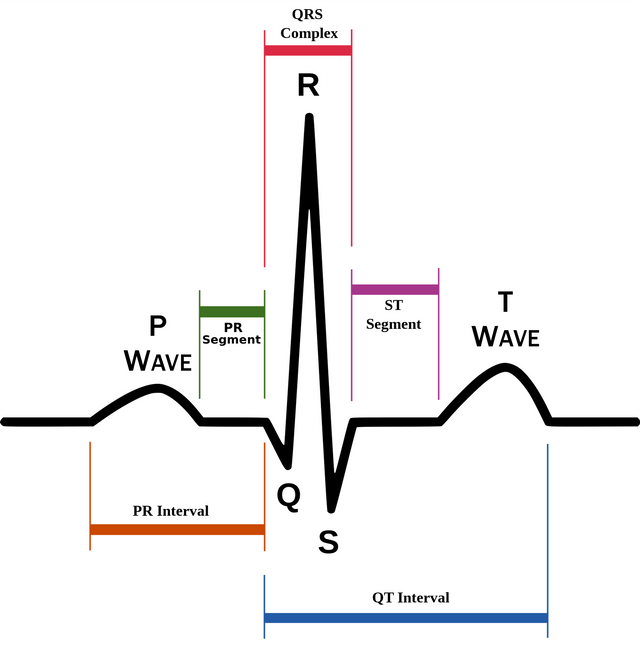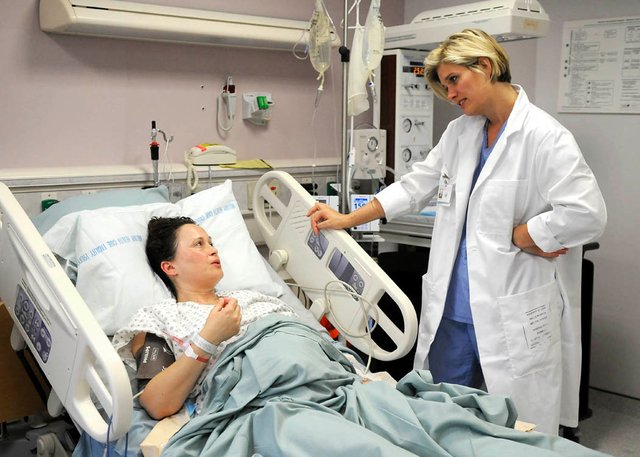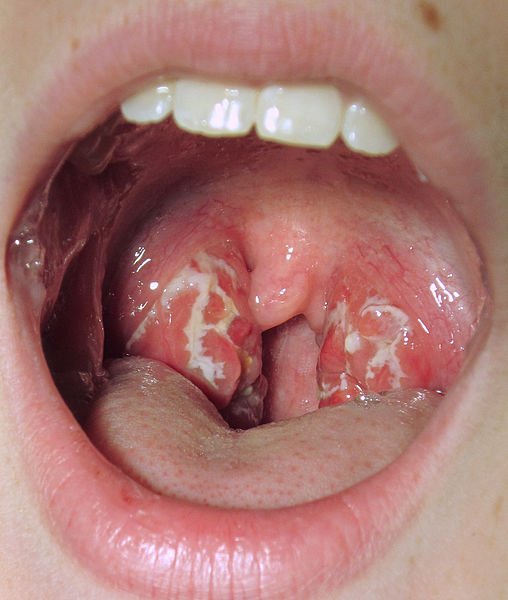RHEUMATIC FEVER — Causes, Symptoms, Tests, Treatment and Diet

Pathophysiology map of rheumatic fever and rheumatic heart disease by Oxynthes, 10/10/10 via wikimedia commons
Rheumatic fever or inflammatory rheumatism is a very serious disease that mainly affects children and young people in their teens. It is thought to be an allergic condition that attacks the connective tissues of the body, causing joint pains and St. Vitus' dance due to central nervous irritation and skin lesions. All these are more or less temporary. The really serious part of this disease is the damage it does to the valves of the heart. Certain streptococcus germs present in the throat are apparently responsible. The body becomes highly sensitized to their presence, and it is this allergic response that harms.
In most cases, the child first develops a sore throat. Several days or weeks later, he may have a fever with aching in the joints, a lack of appetite, profuse sweating, and perhaps even a rash. No two cases are exactly alike in their manifestations. This often makes the diagnosis difficult and uncertain.
Rheumatic fever seems to run in certain families. If both parents have had the disease during childhood, their children are more likely to suffer rheumatic fever. Wherever large numbers of children and young people are gathered together, there is always the likelihood of rheumatic fever. This is because overcrowding, malnutrition, and dampness often play a part. Small outbreaks of rheumatic fever may occur in army barracks.
Two out of every hundred children in school are likely to have some form of rheumatic heart disease. Rheumatic fever causes more deaths during the first twenty year of life than all other infectious diseases put together. These are facts no parent can afford to forget. Rheumatic fever strikes children in every part of the world.
CAUSE OF THE DISEASE
Rheumatic fever usually strikes first in childhood, around eight years of age. The child comes down with a sore throat or cold, followed by an attack of tonsillitis or even Scarlet fever. While he is recovering from the infection, one or two of his larger joints become red, swollen, and tender to the touch. There is also soreness in the muscles and tendons, as well as lack of appetite and a feeling of weakness. Tender nodules may appear on the skin, particularly over certain joints, such as the elbows. Nose bleeding is common in rheumatic fever, even when there has been no injury.
Pains in the chest probably mean that the inflammation has reached the pericardium and the heart muscle itself. The child may develop pneumonia, pleurisy, and even abdominal pain resembling acute appendicitis. The patient may become fidgety owing to Syndenham's chorea, or St. Vitus’s dance. This is more common in girls but also occurs in boys. Hand movements may be rapid, jerky, and irregular, and the patient has a tendency to drop things. There may be muscle weakness and even some difficulty in chewing and swallowing, particularly in younger girls.
Not all cases of rheumatic fever are this definite. In some children, the disease may be of a low-grade, smoldering type with few definite signs. But the child is not well. He is easily fatigued and may not gain weight as he should. He may have a persistently rapid pulse rate and low-grade fever, continuing for long periods of time. The child may complain of “growing pains.” This means an aching pain in the muscles and joints, and perhaps over the heart. Such complaints must be taken seriously. The child should be put to bed and kept there till he is well and strong again. School is much less important than his future health.
SPECIAL TESTS
Unfortunately, there is no specific tests for rheumatic fever. The diagnosis can be made only after a careful study of the patients history, physical examination, and all the laboratory findings. In most cases, both the white blood count and the sedimentation rate are well above normal. The C-reactive protein test may also indicate the presence of inflammatory disease. Other tests, including the antistreptolysin or AST test, may also be elevated. Special smears taken from the back of the throat may reveal the presence of streptococcus germs, but all these tests are only indicators of infection.

Schematic diagram of normal sinus rhythm for a human heart by Agateller (Anthony Atkielski, 13 Jan. 2007 via wikimedia commons
Another important test is the electrocardiogram, although in some cases, it may remain normal. Any disturbance in the normal tracing may indicate some interference in the conduction of electric currents through the heart muscle. Changes in the T waves are also significant, especially in a child suffering from joint pains and fever. Such findings must always be seriously considered. The child must be kept under good nursing care until the electrocardiogram has returned to normal.
X-ray studies of the heart may show that organ to be dilated. During later stages of the disease, the Xrays may show marked changes in the shape of the heart because of damage to the mitral or aortic valves.
Heart murmurs are common during rheumatic fever, but may disappear entirely when the disease clears up, provided the patient has been properly treated. But if the valve cusps are badly damaged, murmurs may return years later as the valves become progressively more deformed. No patient who has had rheumatic fever may be considered to be free of heart disease until he has been observed over a period of many years. The more careful the immediate treatment, the less likelihood of complications later on.
PREVENTION
Rheumatic fever can usually be prevented by treating all patients who have sore throats or other streptococcal infections in the community, and especially in the home. Penicillin is still the best medicine for severe sore throats. If the patient is sensitive to penicillin, tetracycline may be given. The choice of medication must be made by the physician in charge. Patients who have had rheumatic fever or rheumatic heart disease should be given penicillin or some other medication regularly for at least the next twenty years, or preferably for life.
TREATMENT

US Navy midwife checks on a mum by Suzanne M. Day, 2nd Oct., 2008 via wikiedia commons
Keep the patient in bed until all evidence of rheumatic fever has disappeared. This may take several months or even a year. The patient should be kept as quiet as possible. Take his temperature once or twice daily. When he feels better, and the temperature has returned to normal, he may be up and about for limited periods of each day. But any strenuous exercise should not be permitted for at least one year or longer, depending on his condition.
Good nursing care is always the secret of success. Note carefully the condition of the skin, using rubbing alcohol or some similar preparation to keep down irritation. A heating cradle is beneficial in treating swollen joints. In severely ill patients the fever may be very high. Absolute bed rest is important in such cases.
MEDICATIONS
Most doctors give some form of salicylate, such as aspirin, several times a day to reduce the fever. Always take the medicine with a little milk, because salicylate tablets tend to burn the lining of the stomach. In the more severe cases, cortisone products or sulphadiazine are of value. ACTH may also be used. Penicillin helps to clear out the hemolytic streptococcus germs from the throat. The more severe cases are best treated in hospital to prevents further cardiac damage. Some may require oxygen and other medications to help the circulation.
DIET
.jpg)
Image of healthy foods, including fruit, vegetables, fish and bread via wikimedia commons
Liquid and soft diet are preferred in the early stages of rheumatic fever. The patient should be given plenty of water and other liquids, especially if he has a high fever. Keep him in bed in a quiet, restful environment, preferably at home. Some mild sedation if he is nervous and jittery, for it’s most important to keep the patient quiet in order to protect his heart from further damage. As long as there is a high white count, an elevated sedimentation rate, or change in the electrocardiogram, the patient should remain in bed. He should be seen frequently by his own physician. With proper rest and the right kind of care, even the worst case will soon improve and may even make an almost complete recovery.
References for further read:
- Wikipedia: What is rheumatic fever
- Mayo clinic: Rheumatic fever, symptoms, causes and treatment
- Atrial fribrillation: Understandig the EKG signal
- MedlinePlus: How to test for Rheumatic fever
- Medscape: Rheumatic Fever Medication
If you write STEM (Science, Technology, Engineering, and Mathematics) related posts, consider joining #steemSTEM on Steemit.chat or Discord here. If you are from Nigeria, you may want to include the #stemng tag in your post. You can visit this blog by @stemng for more details. You can also check this blog post by @steemstem here and this guidelines for help on how to be a member of @steemstem. Please also check this blog post from @steemstem on proper use of images devoid of copyright issues here



What makes a liquid diet, fruit juice?
This is a very informative post. Children's health should be highly monitored.
#bigwaves
All forms of healthy liquid are welcome. Water, the first and most important. Fruit juice too (100% fruit content).
Thanks dear!
Congratulations! Your post has been selected as a daily Steemit truffle! It is listed on rank 13 of all contributions awarded today. You can find the TOP DAILY TRUFFLE PICKS HERE.
I upvoted your contribution because to my mind your post is at least 10 SBD worth and should receive 117 votes. It's now up to the lovely Steemit community to make this come true.
I am
TrufflePig, an Artificial Intelligence Bot that helps minnows and content curators using Machine Learning. If you are curious how I select content, you can find an explanation here!Have a nice day and sincerely yours,

TrufflePigGood job!